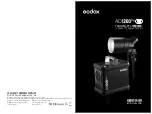
Screwdriver use
Note:
Always use a universal bit holder when working with screwdriver bits. Do not mount
screwdriver bits directly into the chuck.
1. Select gear 1 using the Gear Switch (4).
2. Rotate the Mode Selector (3) to Drive.
3. Adjust the drill to the appropriate torque setting (see ‘Torque control’ )
- When driving screws NEVER use the machine in drill mode.
Note:
If in doubt which torque setting best suits the application, start with a low setting and
increase, should more torque be required (e.g. if the screw is not being driven far enough into
the work piece).
Drilling masonry and concrete
1. Select gear 1 using the Gear Switch (4)
2. Rotate the Mode Selector (3) to the hammer drill position.
- Hammer drill mode should be used for drilling into masonry and concrete.
- Apply moderate pressure to the rear of the drill, in line with the drill bit.
- Use masonry drill bits only. Ensure that the bit size is within the maximum capacity of the
machine (see ‘Specification’ ).
- DO NOT apply too much pressure. If debris blocks the drill hole, run the drill slowly and
remove the bit from the hole. Repeat until hole is cleared.
WARNING:
The drill bit, especially the tip, will become very hot when drilling masonry and
concrete.
DO NOT touch the bit and never allow it to come into contact with combustible materials.
WARNING:
DO NOT inhale masonry dust. Wear adequate breathing protection. Dust from
masonry, concrete and similar substances is harmful and may be toxic.
Drilling wood
1. Select the appropriate gear using the Gear Switch (4)
2. Rotate the Mode Selector (3) to the drill position
- Ensure that drill bits are suitable for wood, and are within the maximum capacity of this
machine (see ‘Specification’ )
WARNING:
DO NOT inhale wood dust. Wear adequate breathing protection. Some wood dusts
may be toxic.
Drilling meta
1. Select the appropriate gear using the Gear Switch (4)
2. Rotate the Mode Selector (3) to the drill position
- Ensure that drill bits are suitable for the grade of metal being drilled, and are within the
maximum capacity of the machine (see ‘Specification’ ).
- To ensure accuracy, mark the intended hole position using a hammer and centre punch.
WARNING:
The drill bit and the work piece will become very hot when drilling metal. DO NOT
touch the bit and never allow it to come into contact with combustible materials when hot. Always
use a suitable lubricant or cutting fluid, and drill at appropriate speeds.
- ONLY apply moderate pressure to the drill bit, ensuring efficient cutting and prolonged drill bit
life.
- Use a countersink bit to remove sharp burrs from the hole, preventing cuts and other kinds of
injury.
WARNING:
If the power tool gets excessively hot in use, stop using the tool immediately and
allow to cool before continuing work. The cooling period can be reduced by operating the drill at
maximum speed with no load. Always make sure the Motor Vents (5) are not blocked and do not
allow dust to enter the body of the tool through the Motor Vents; dust, especially metallic dust,
may damage or destroy the tool.
Install Belt Clip
The Belt clip is convenient for temporarily hanging the tool.
This can be installed on the tool.To install the belt clip,install
it into a groove in the tool housing and then secure it with a
Screw.To remove loosen the screw and take it out.
Maintenance
WARNING:
ALWAYS disconnect from the mains power supply, before carrying out any
maintenance/ cleaning of the charger. Remove the battery before carrying out any maintenance/
cleaning of the drill.
Note:
Both the drill and the charger contain no user-serviceable parts. If the device does not
perform as outlined in this manual, return it to an authorised GMC service centre for repair
General inspection
- Regularly check that all the fixing screws are tight
- Inspect the supply cord of the tool, prior to each use, for damage or wear. Repairs should be
carried out by an authorised service centre. This advice also applies to extension cords used with
this too.
Cleaning
- Keep your tool clean at all times. Dirt and dust will cause internal parts to wear quickly, and
shorten the machine’ s service life. Clean the body of your machine with a soft brush, or dry
cloth. If available, use clean, dry, compressed air to blow through the ventilation holes
- Clean the tool casing with a soft damp cloth using a mild detergent. Do not use alcohol, petrol
or strong cleaning agents
- Never use caustic agents to clean plastic parts
Lubrication
- Slightly lubricate all moving parts at regular intervals with a suitable spray lubricant
Storage
- Store this tool carefully in a secure, dry place out of the reach of children
Disposal
Always adhere to national regulations when disposing of power tools that are no
longer functional and are not viable for repair.
- Do not dispose of power tools, or other waste electrical and electronic equipment
(WEEE), with household waste
.
- Contact your local waste disposal authority for information on the correct way to dispose of
power tools
Li-Ion
11
- -


































